As of 2024, the BMAT will no longer operate for Medicine applicants. Applicants for all UK medical schools will be required to sit the University Clinical Aptitude Test (UCAT) for 2025 Entry. Find out more in our BMAT/UCAT 2025 Guide.
We know that preparing and taking the BMAT is stressful, as is waiting for your results. But don’t worry, we’ve got you covered.
Up until now, it’s likely most of your exams have been scored as a percentage, with the aim of getting as close to 100% as possible. However, BMAT scoring is slightly different. There is no pass or fail threshold — you simply have to do your best and you’ll be graded accordingly.
In this article, we provide everything you need to know how the BMAT is scored and what you should expect to see from your results, including what would commonly be considered a good score in each section.
How Is The BMAT Section 1 and 2 Scored?
For Sections 1 and 2, you will gain 1 mark for each correct answer and 0 marks for each incorrect answer. Your raw mark will then be placed on a scale from 1.0 to 9.0 to make up your score for each section.
Section 1
Each answer you get right after 2 – 3 correct answers will raise your score, which begins at the minimum 1.0, by 0.2 – 0.4. Historically, this has stood true until 31 total marks, at which point you have hit the maximum score of 9.0. The specification was updated so that Section 1 only has 32 questions in total – we’d expect the 9.0 cut-off to be around 28/29 out of 32.
Section 2
This is scored similarly. Once you have answered 1 question correctly, each correct answer will raise your score by 0.3-0.7. This runs up to the maximum BMAT score of 9.0 after 23 correct answers. It’s also important to remember that the exact score conversions for both Sections 1 and 2 change slightly each year, so it’s difficult to predict the exact marks needed for a given score in an upcoming assessment.
Your Medical Interviews are just around the corner. Don’t wait for your invitations, early Interview preparation gives you the best chance of receiving offers.
With over 95 hours of guided study (including One-To-One Tuition, Intensive Courses and Comprehensive Materials), our expert Oxbridge Medical Interview support truly gives you an advantage that can make the difference between an offer and rejection.
Discover our Oxbridge Medical Interview Programme by clicking the button below to enrol and triple your chances of success.
How Is The BMAT Section 3 Scored?
Section 3 is scored differently to Sections 1 and 2. This essay section is marked by two examiners in order to prevent personal bias, as essays are much more subjective in terms of grading.
Each applicant is graded by two separate factors, both of which run on a much more limited scoring spectrum. You will receive an alphabetical score for your use of English which can be;
(Highest) A – Good use of English throughout. Clear, fluent, good sentence structure and use of vocabulary.
(Middle) C – Reasonably clear use of English. The answer will be reasonably fluent with an unambiguous sentence structure. Grammar will be acceptable with a few errors.
(Bottom) E – Weak use of English. The text does not flow coherently. There will be flawed sentence structure, a limited use of vocabulary and flawed grammar.
For the quality of content, the examiners consider whether or not the candidate has fully addressed the question, the structure of the essay and the use of general knowledge, current affairs and opinions. Candidates receive a score from 1.0 to 5.0, with 3.0 being the average score in the cohort.
1 – This will have an answer that has some bearing on the question but does not address the question properly, therefore your answer may be incoherent and without focus.
3 – This will be a reasonably well argued answer than addresses all components of the question. Use of materials provided will be acceptable, and the argument or proposition made will be natural. This is the average grade most candidates receive.
5 – This will be an exemplary answer with no significant downfall. Every aspect of the question asked will be addressed with a strong argument or counter. The answer will have made good use of the material provided; the whole answer will be cohesive and flow naturally, ending with a solid conclusion.
Scores 2 and 4 fall in-between the corresponding mark schemes.
Around 80% of candidates receive a Band A for quality of English! Some medical schools, such as Imperial, set a cut-off for this score, so they will not accept anyone with a quality of English score lower than a B. So, it’s important that you aim for a Band A – it really doesn’t take much effort to proofread and check your spelling!
What is a Good BMAT Score?
In Sections 1 and 2, the scores are distributed normally so most students score in the middle part of the range, with the average student scoring 5.0. Strong candidates score around 6.0 and exceptional candidates score around 7.0, so these would definitely be classed as good scores.
For Section 3, 4.0 is a strong score and 5.0 is outstanding and rarely seen. As previously stated, the majority of applicants receive and A for the quality of their English, so this is expected for most successful applicants.
Growing competition for places at medical school means that the parameters for what constitutes a good score this year might look different the following year. This isn’t anything to worry about, but it’s worth bearing in mind when you compare past BMAT results to yours. An acceptable score may also vary from university to university.
When are BMAT results released?
The release date of your BMAT results depends on when you completed the test, though it will always be a few weeks after. For example, results from the BMAT October 2022 session will be released on 25th November 2022.
How do you see your BMAT Results?
You’re able to see your BMAT results when they are ready by accessing the Metritests System through Cambridge Assessment. Log in using the details you registered with and find out how well you did. Most universities will receive your results automatically, so you don’t need to worry about providing them.
What does the BMAT score mean?
The BMAT score looks different to your GCSE exam results. However, it should be fairly easy to understand if you have learnt how the BMAT is marked. As we already know, Sections 1 and 2 are marked on a scale of 1.0 (low) to 9.0 (high). Although the score goes up to 9.0, fewer than 1% of candidates receive this. Every question within these is awarded one mark for each correct answer, before being added up and correlated into a BMAT score for both sections. The conversions from raw marks to BMAT scores for a given paper are made publically available following the release of results statistics for said paper.
Section 3 differs from the previous two with it’s grading system judging Quality of Content (1- 5) and Quality of English (A – E). When you receive your BMAT results, your Section 3 grade will look like, for example, 4A.
If, after receiving your BMAT results, you feel it’s been unfairly marked, you can request a remarking at a charge of £33. In general, the BMAT is a very difficult test to score highly on, as it intends to identify the highest-performing candidates to attend the best calibre of university courses. Our past BMAT papers will help you prepare for the admissions test.
Different Universities use the BMAT in Different Ways
There are eight universities that use the BMAT score to support medical course applications. However, not every institution is the same. Some emphasise a specific section score, and others use it in conjunction with your application. Not every university reveals its process either, so a good score is essential to boost your chances of being invited to Interview regardless of where you’re applying to.
Some universities may set a BMAT cut-off score. Some may use it in conjunction with academic results or Personal Statements for Interview selection and some may not consider the BMAT at all until the final decision is being made. Some schools will place more emphasis on Section 3 than others. This is why it is hard to say what a good score on the BMAT is.
You should take the time to research how the Medical or Dental Schools that you want to apply to make use of your BMAT score and apply by playing it to what you believe your strengths are. For example, if you think that you are good at writing essays, you could apply to a university that places a lot of emphasis on the Section 3 score. This is something that’s important to remember. A strong BMAT score only helps you if you use it in the right way!
2023 BMAT Results
2023 will be the final year of BMAT testing as it currently stands. This means that this is the final set of results that applicants will receive from this test. It is still unknown how all universities will replace the BMAT, although some have already announced their shift to the UCAT.
Once again, the BMAT was sat two weeks earlier than pre-2022 tests, in the middle of October rather than the first week of November. This meant candidates had two weeks less to prepare.
Section 1
As the BMAT was sat at around the same date in 2023 as 2022 (compared to 2022 vs 2021), it is much easier to compare the two sets of results.
This year, the modal score was 4.4, 0.3 points higher than in 2022. Roughly 6.5% of applicants achieved this score, which is slightly less than the modal score from 2022.
Anything above a 6.0 is seen as a comparatively high score, with the most exceptional students achieving above a 7.0. As we can see, ~2.5% of candidates achieved such a score, which is 0.5% lower than in 2022.
- ~13.5% of candidates scored above a 6.0, more than in 2022.
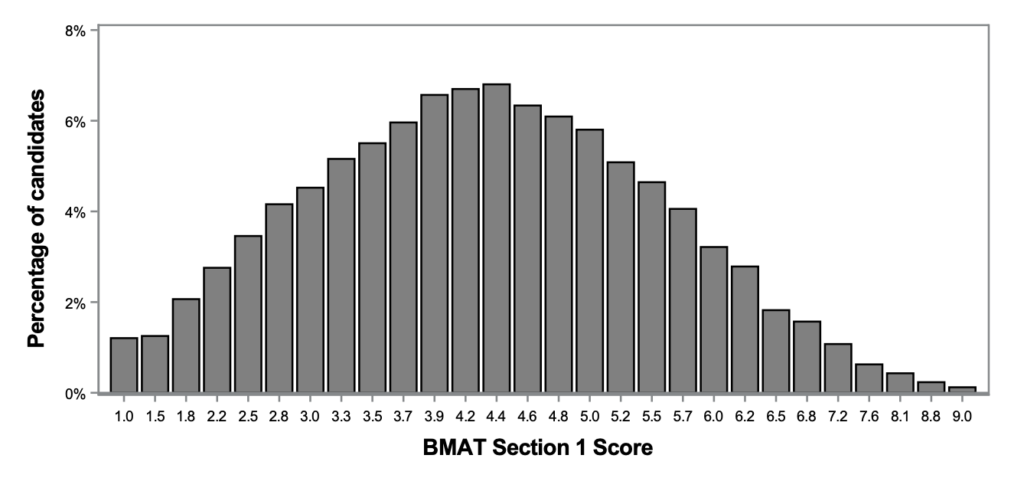
Section 2
Like 2022, applicants typically scored lower in Section 2, with a score distribution leaning on the lower end and a most common score of 3.8, achieved by around 9% of the cohort. This is significantly lower than last year, where the most common score was 4.2, indicating this was a harder paper.
However, the distribution curve itself is slightly wider than last year’s, and it seems that more applicants scored over 5.0, with a difference of roughly 4% going off of the limit data the graph provides.
- ~67% of candidates scored 5.0 or below.
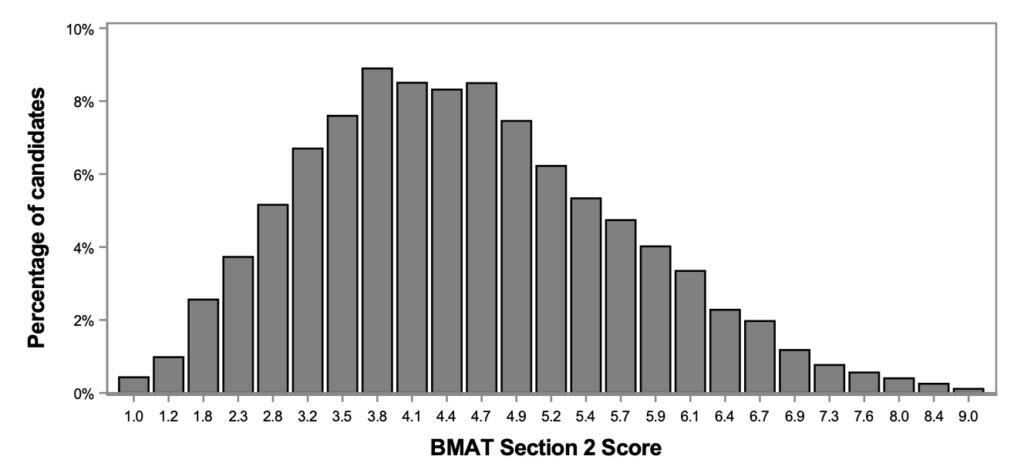
Section 3
As always, 3A is the most common score in Section 3. Almost all score distributions in 2023 are identical to last year, with the only major difference being that noticeably few applicants achieved a quality score of 2.5 this year.

Previous results explained
2022 BMAT Results
Section 1
Despite having less time to prepare, candidates performed on par compared to previous years in Section 1. However, it is difficult to directly compare with 2021 due to Cambridge presenting the scaled results to .5 decimal places last year – this does mean there is more granular data this year for candidates to see how well they performed.
The modal score was 4.1, with ~7% of candidates achieving this. This is on par with previous years, with 4.0 being the modal score in 2021 and 4.5 in 2020.
~3% of candidates achieved a score of over 7.0, which is roughly the same amount as in 2021.
- ~13% of candidates scored above a 6.0, more than in 2021.
- ~54% of candidates scored between 3.6 and 5.7 which is a decrease on 2021 but is on par with candidates from 2020.
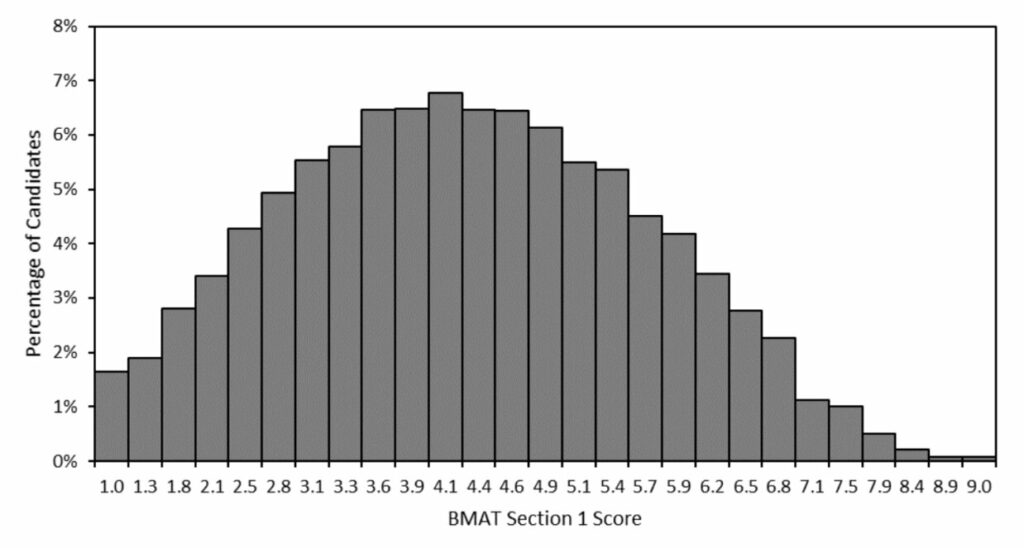
Section 2
Comparing Section 1 and Section 2, we can see that students have done better in the former. Below you can see that the scores are skewed more towards the lower end of the scale. The modal score was 4.2 with ~9% of candidates achieving this, which is obviously below the 5.0 mark. Typical candidates will achieve a score of 5.0, with ~7% doing so.
- ~71% of candidates scored 5.0 or below.
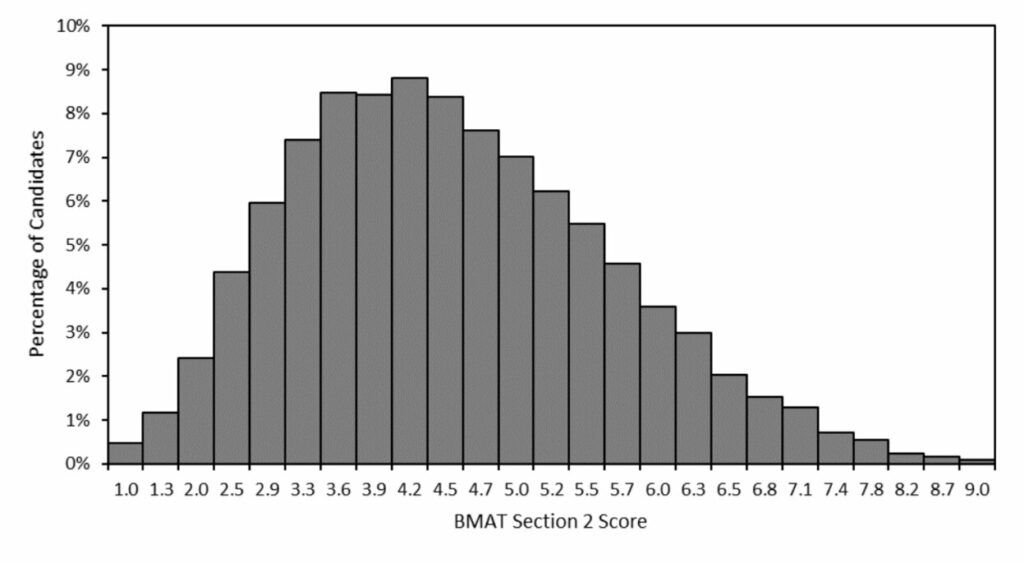
Section 3
Once again in Section 3, a score of 3A is by far the most popular. A staggering ~75% of candidates achieved a score of A for their quality of English. This has been the most common score for the past few years therefore, it is safe to say that the return to pen-and-paper has had no impact on candidates’ performance.

2021 BMAT Results
Section 1
Students were once again plagued with technical issues during 2021’s BMAT, with 95% of candidates experiencing issues with their Admissions Test.
Some of the issues that candidates faced were:
- Test started late
- Tech issues causing reduced time
- Questions did not load properly
- Software glitches, preventing them from continuing
- Invigilators taking up valuable time
Despite the issues that candidates were faced with, the average score for section 1 was around 4.0, slightly below what candidates scored in 2020. A 6.0 represents a comparatively high score, with roughly 13.5% of candidates achieving above that. It is worth noting that in 2020, Cambridge Admissions Assessment released more granular data, but have reverted back to the 0.5 increments that have been used in the past.
- In 2020, around ~56.5% of candidates scored between 3.5 and 5.5 in section 1
- In 2021, this has seen a significant increase with ~63% achieving a score between 3.5 and 5.5.
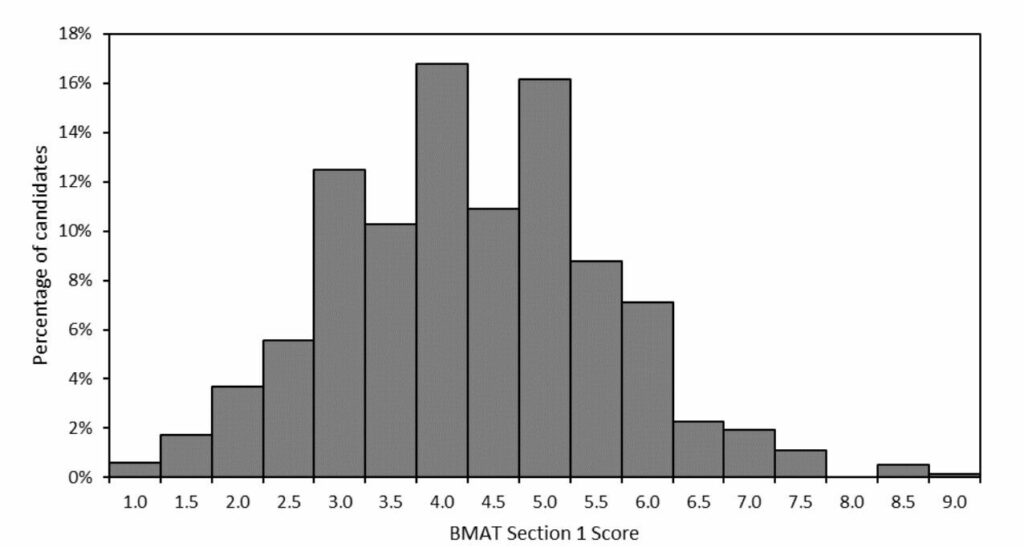
Section 2
Comparing section 1 and section 2, we can see that students have done better in the former. A 4.0 was once again the average score, as it was in section 1, with 17% of candidates achieving it. We can see that candidates found section 2 hard as only 16% of candidates scored between 6.0 and 9.0.
- The mean score of 4.0 puts 2021 below the 2020 averages again, where 4.6 was the mean score. However, as already mentioned in 2020 more granular data was provided than has been this year.
- An impressive 48% of candidates scored a 4.5 or above.
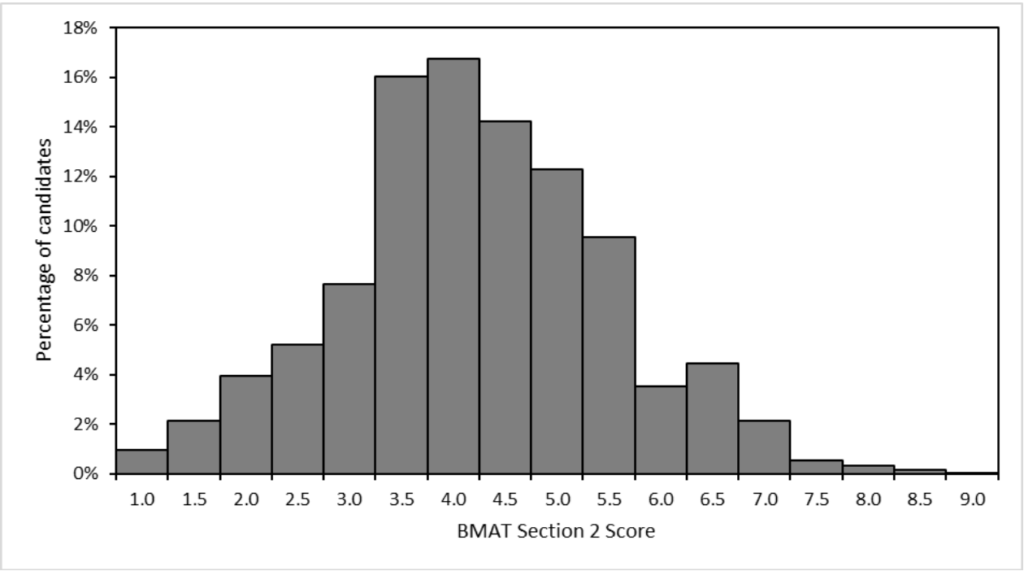
Section 3
In section 3, a 3A was overwhelmingly the most popular score – as has been the case for the last few years. A staggering 75% of candidates achieved a score of A for their quality of English. As with 2020, it is clear that despite the issues candidates were faced with they have been able to score representatively.
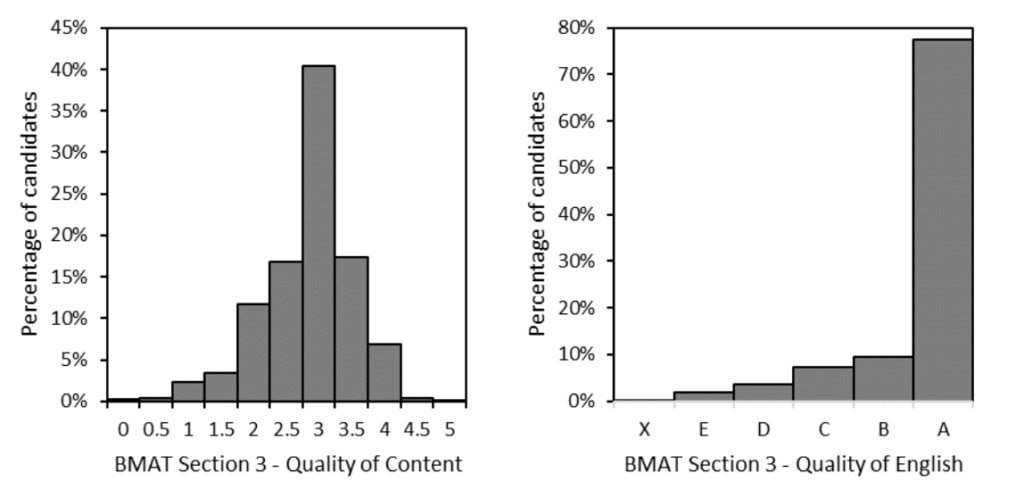
2020 BMAT Results
Section 1
2020’s exam differed from previous years’ due to technical problems, with 80% of candidates facing issues during the test. Despite this, the average score for section 1 was around 4.5, which is similar to 2019, just slightly higher. Something interesting to note though is that the Cambridge Admissions Assessment released more granular data than before as the increments for each bar increase roughly by 0.2 – 0.3. In previous years, they have released scores with an increase of 0.5 between each bar. These changes allow candidates to see the differences in median range more clearly, which most participants would have received a score in.
- In 2019, around ~58% of candidates scored between 3.5 and 5.5 in section 1.
- In 2020, this reduced marginally to ~56.5% between 3.5 and 5.5 — not a significant change.
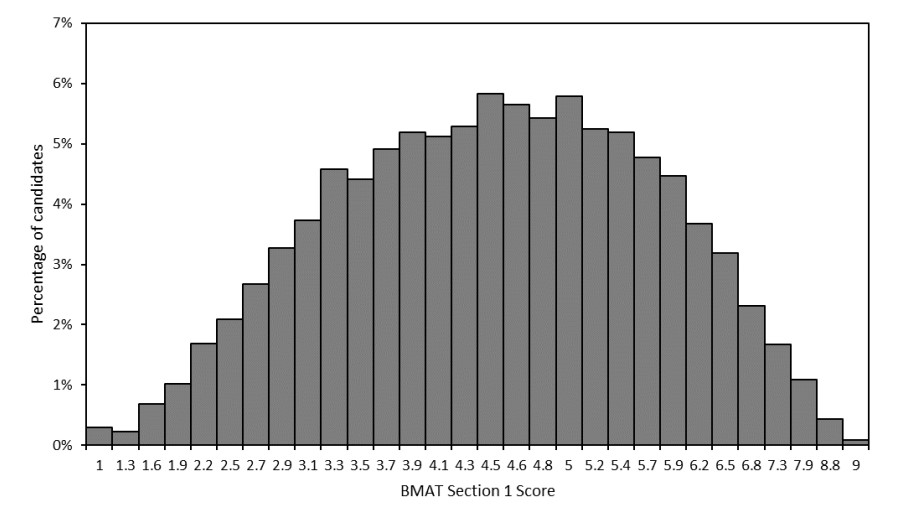
Section 2
By comparing section 1 and 2 results, it’s clear that students found section 2 more difficult than section 1. There are only seven physics questions in section 2, however, this can make a huge difference when it comes to the scaled score. A seven mark difference in previous years from 15 to 22 would have meant a scaled score of 5.2 to 7.2 – a big difference of 2.0.
- In 2020, the mean score was 4.6, compared to 3.5 – 4.0 in 2019.
- Around 45% of candidates scored above 4.6 in 2020.
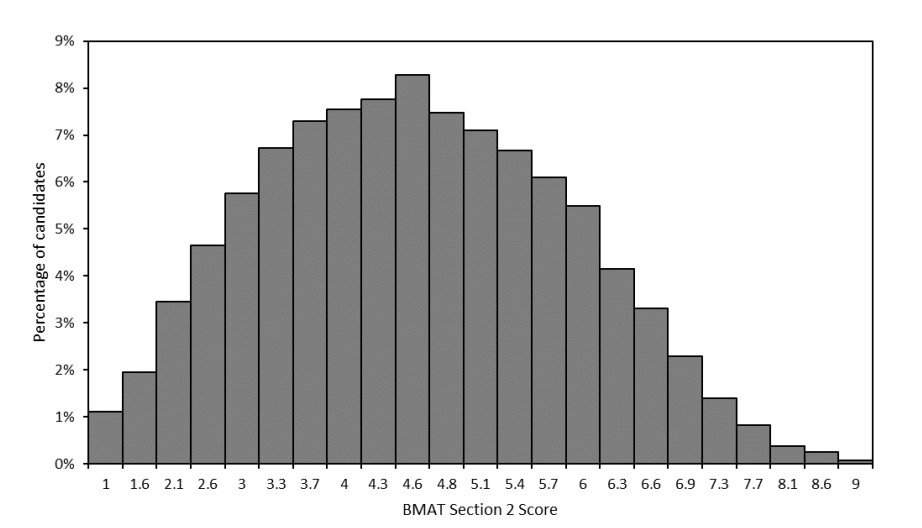
Section 3
Meanwhile, 3A was the most popular score in section 3, the same as previous years. Although most sat their exam using a computer rather than pen and paper, this seems to have had no impact on the essay section of the BMAT. Overall, a good BMAT score for 2020 looked like: 5.2, 5.1, and 3.5A.

Now you’ve had a chance to look through this year’s results, how did you do? Remember that comparing yourself to others will not definitively tell you if you will be invited to Interviews or not.
The next step is to start preparing for your Medicine Interviews. Performing well is crucial to receiving an offer, so we implore you to start preparing as early as possible. You should never wait for your Interview invitation to start preparing as Medical Schools can send invitations with just a few days notice.
There’s only one thing standing between you and your Medicine offer. Effective Interview preparation is the best way to strengthen your application.
Our Oxbridge Medical Interview Programme effectively prepares you through One-To-One Tuition, Intensive Courses, Comprehensive Materials and Enrichment Supervisions to give you the best chances of Medicine success.
Discover how you can enrol and triple your chances of success today by clicking the button below.








